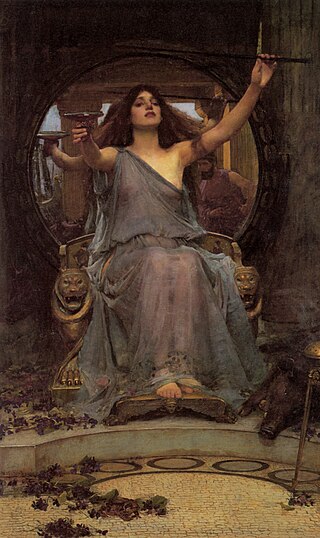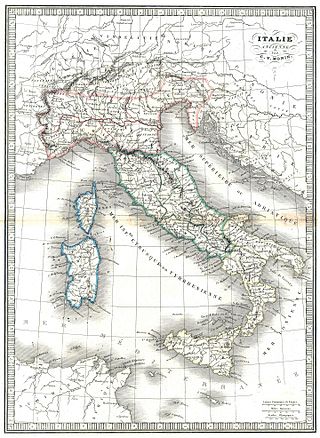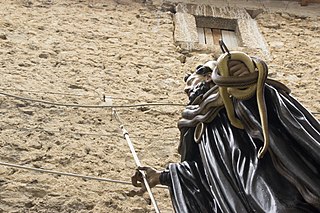
Circe is an enchantress and a minor goddess in ancient Greek mythology and religion. In most accounts, Circe is described as the daughter of the sun god Helios and the Oceanid nymph Perse. Circe was renowned for her vast knowledge of potions and herbs. Through the use of these and a magic wand or staff, she would transform her enemies, or those who offended her, into animals.
Hecate is a goddess in ancient Greek religion and mythology, most often shown holding a pair of torches, a key, or snakes, or accompanied by dogs, and in later periods depicted as three-formed or triple-bodied. She is variously associated with crossroads, night, light, magic, protection from witchcraft, the Moon, graves, and ghosts. Her earliest appearance in literature was in Hesiod's Theogony in the 8th century BCE as a goddess of great honour with domains in sky, earth, and sea. Her place of origin is debated by scholars, but she had popular followings amongst the witches of Thessaly and an important sanctuary among the Carian Greeks of Asia Minor in Lagina. Her oldest known representation was found in Selinunte, in Sicily.

Minerva is the Roman goddess of wisdom, justice, law, victory, and the sponsor of arts, trade, and strategy. Minerva is not a patron of violence such as Mars, but of strategic war. From the second century BC onward, the Romans equated her with the Greek goddess Athena. Minerva is one of the three Roman deities in the Capitoline Triad, along with Jupiter and Juno.

In Greek mythology, Medea is the daughter of King Aeëtes of Colchis. In the myth of Jason and the Argonauts, she aids Jason in his search for the Golden Fleece. She later marries him, but eventually kills his children and his other bride. Medea is known in most stories as a sorceress and is often depicted as a priestess of the goddess Hecate. She first appears in Hesiod's Theogony around 700 BCE, but is best known from Euripides's tragedy Medea and Apollonius of Rhodes's epic Argonautica.

In ancient Roman religion, Ceres was a goddess of agriculture, grain crops, fertility and motherly relationships. She was originally the central deity in Rome's so-called plebeian or Aventine Triad, then was paired with her daughter Proserpina in what Romans described as "the Greek rites of Ceres". Her seven-day April festival of Cerealia included the popular Ludi Ceriales. She was also honoured in the May lustration (lustratio) of the fields at the Ambarvalia festival: at harvest-time: and during Roman marriages and funeral rites. She is usually depicted as a mature woman.

The Sabines were an Italic people who lived in the central Apennine Mountains of the ancient Italian Peninsula, also inhabiting Latium north of the Anio before the founding of Rome.
The Marsi were an Italic people of ancient Italy, whose chief centre was Marruvium, on the eastern shore of Lake Fucinus. The area in which they lived is now called Marsica. They originally spoke a language now termed Marsian and attested by several inscriptions.
The Paeligni or Peligni were an Italic tribe who lived in the Valle Peligna, in what is now Abruzzo, central Italy.

Aeaea, Ææa or Eëä was a mythological island said to be the home of the goddess-sorceress Circe.
"Circe would fain have held me back in her halls, the guileful lady of Aeaea, yearning that I should be her husband"..

Astarte is the Hellenized form of the Ancient Near Eastern goddess ʿAṯtart. ʿAṯtart was the Northwest Semitic equivalent of the East Semitic goddess Ishtar.

The Umbri were an Italic people of ancient Italy. A region called Umbria still exists and is now occupied by Italian speakers. It is somewhat smaller than the ancient Umbria.

Civita d'Antino is a comune and town in the province of L'Aquila, in the Abruzzo region of Central Italy.

In Greek mythology, Dike or Dice is the goddess of justice and the spirit of moral order and fair judgement as a transcendent universal ideal or based on immemorial custom, in the sense of socially enforced norms and conventional rules. According to Hesiod, she was fathered by Zeus upon his second consort, Themis. She and her mother are both personifications of justice. She is depicted as a young, slender woman carrying a balance scale and wearing a laurel wreath. The constellation Libra was anciently thought to represent her distinctive symbol.

In ancient Roman religion and mythology, Mars is the god of war and also an agricultural guardian, a combination characteristic of early Rome. He is the son of Jupiter and Juno, and was pre-eminent among the Roman army's military gods. Most of his festivals were held in March, the month named for him, and in October, the months which traditionally began and ended the season for both military campaigning and farming.

In classical mythology, Cupid is the god of desire, erotic love, attraction and affection. He is often portrayed as the son of the love goddess Venus and the god of war Mars. He is also known as Amor. His Greek counterpart is Eros. Although Eros is generally portrayed as a slender winged youth in Classical Greek art, during the Hellenistic period, he was increasingly portrayed as a chubby boy. During this time, his iconography acquired the bow and arrow that represent his source of power: a person, or even a deity, who is shot by Cupid's arrow is filled with uncontrollable desire. In myths, Cupid is a minor character who serves mostly to set the plot in motion. He is a main character only in the tale of Cupid and Psyche, when wounded by his own weapons, he experiences the ordeal of love. Although other extended stories are not told about him, his tradition is rich in poetic themes and visual scenarios, such as "Love conquers all" and the retaliatory punishment or torture of Cupid.
Emma Dench is an English ancient historian, classicist, and academic administrator. She has been McLean Professor of Ancient and Modern History at Harvard University since 2014, and Dean of its Graduate School of Arts and Sciences since 2018. Her previous positions include Professor of Ancient History at Birkbeck College, University of London and Professor of Classics and of History at Harvard.

The Festival of the snake catchers is an annual festival held on May 1 in Cocullo, Italy in honour of St. Dominic di Sora, patron saint protecting against snakebite and toothache. Its origins date back to paganism and have roots in an ancient celebration in honour of the Roman goddess Angitia. The festival involves a procession carrying the statue of St. Dominic, draped with live snakes, through the streets of the village.

Circe is a 2018 novel by American writer Madeline Miller. Set during the Greek Heroic Age, it is an adaptation of various Greek myths, most notably the Odyssey, as told from the perspective of the witch Circe. The novel explores Circe's origin story and narrates Circe's encounters with mythological figures such as Hermes, the Minotaur, Jason, and Medea, and ultimately her romance with Odysseus and his son, Telemachus.
Gale is a minor character in Greek mythology. She was a very skillful witch who earned the wrath of Hecate, the Greek goddess of magic.














